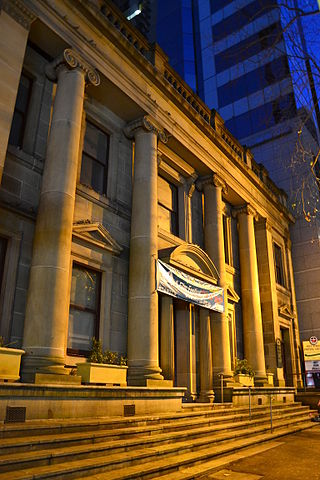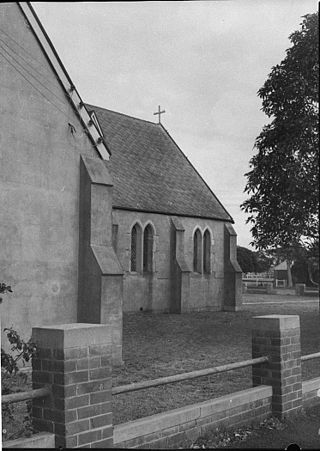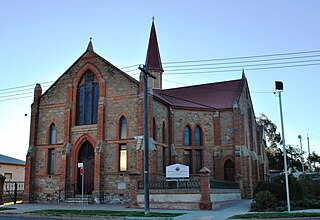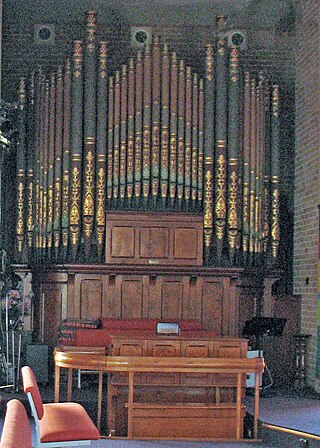
Burwood is a suburb in the Inner West of Sydney, in the state of New South Wales, Australia. It is 10 kilometres (6.2 mi) west of the Sydney central business district and is the administrative centre for the local government area of Municipality of Burwood. People from Burwood are colloquially known as Burwoodiens or Burwooders.

The Pitt Street Uniting Church is a heritage-listed Uniting church building located at 264 Pitt Street in the Sydney central business district, Australia. Founded in 1833, the congregation was the original church of Congregationalism in New South Wales. The church building was designed by John Bibb and built from 1841 to 1846. It is also known as Pitt Street Congregational Church. The property is owned by The Uniting Church in Australia and was added to the New South Wales State Heritage Register on 2 April 1999.
George Allen Mansfield was a prominent Australian architect of the nineteenth century who designed many iconic buildings in Sydney, New South Wales, Australia.

Albert Street Uniting Church is a heritage-listed Uniting church at 319 Albert Street, Brisbane City, City of Brisbane, Queensland, Australia. It was designed by George Henry Male Addison and built from 1888 to 1889 by Thomas Pearson & Sons. It was originally known as Albert Street Methodist Church and Central Methodist Mission. It was added to the Queensland Heritage Register on 21 October 1992.

Ipswich Uniting Church is a heritage-listed Uniting church at Ellenborough Street, Ipswich, City of Ipswich, Queensland, Australia. It was designed and built by Samuel Shenton in 1858. It is also known as Ipswich Central Mission, Wesleyan Chapel, Ellenborough Street Methodist Church, and Ipswich City Uniting Church. It was added to the Queensland Heritage Register on 21 October 1992.

Surface Hill Uniting Church is a heritage-listed former Uniting church at Channon Street, Surface Hill, Gympie, Gympie Region, Queensland, Australia. It was designed by architect Hugo William Du Rietz and built from 1869 to 1937. It is also known as City Church, Surface Hill Methodist Church and Wesleyan/Wesley Church. It was added to the Queensland Heritage Register on 30 May 2003.

The St John's Anglican Church, formally the Church of St John the Evangelist, also called St John's Cooks Hill, is an Anglican church in Newcastle, New South Wales, Australia. It is the oldest remaining church building in Newcastle, completed in 1860. The building, the design of which is attributed to colonial architect Edmund Blacket, in the Old Colonial Grecian Revival style, is located close to the city centre at 1D Parry Street, Cooks Hill. It was added to the New South Wales State Heritage Register on 2 April 1999.

Blayney Uniting Church is a heritage-listed Uniting church at Adelaide Street, Blayney, Blayney Shire, New South Wales, Australia. The property is owned by the Uniting Church in Australia. It was added to the New South Wales State Heritage Register on 2 April 1999.

Wesley Uniting Church is a heritage-listed Uniting church at Cobalt Street, Broken Hill, City of Broken Hill, New South Wales, Australia. It was designed by Frederick William Dancker and built from 1885 to 1888 by Messrs. Walter and Morris. It is also known as Wesley Uniting Church and Hall Group, Wesleyan Uniting Church Group, Wesley Church and Wesley Hall. The property is owned by the Uniting Church in Australia. It was added to the New South Wales State Heritage Register on 23 April 2010 and on the Australian Register of the National Estate.

St Mary's Anglican Church is a heritage-listed Anglican church and associated facilities located at 240 Birrell Street, Waverley, in the Waverley Municipality, Sydney, New South Wales, Australia. The church was designed by Edmund Blacket and built between 1863 and 1864. It is very well known and sought after as a place to be married and is popular for funerals. The building is also notable due its pipe organ, designed and built by August Gern. The property is used for ministry by the Anglican Parish of Bondi and Waverley, which is an amalgamation of two previous Parishes ; The first Rector of St Mary’s Waverley, Rev Stanley Mitchell, was a keen Evangelical and although he used traditional Anglican liturgy was “low church” like most of Sydney Diocese. However there has been a long history of more “High” Anglicanism and Anglo Catholic theological underpinnings. Since 2014, the church has returned to a strongly evangelical base while running a very strong traditional 1662 prayer book communion service every Sunday. It also has less traditional al services to accommodate more contemporary congregations.

The Galston Uniting Church Pipe Organ or Pipe Organ from Bourke Street Congregational Church is a heritage-listed church pipe organ located at 11 School Road, Galston in the Hornsby Shire local government area of New South Wales, Australia. It was built by Forster and Andrews. It is also known as Pipe Organ from Bourke Street Congregational Church (former) and Forster and Andrews Pipe Organ; Galston Uniting Church Pipe Organ. The property is owned by Uniting Church in Australia. It was added to the New South Wales State Heritage Register on 2 April 1999.

The Chatswood South Uniting Church is a heritage-listed Uniting church at 518 Pacific Highway, Lane Cove North in the Lane Cove Council local government area of New South Wales, Australia. It was designed by Thomas Rowe and possibly a Mr Morrow also and built by Bryson, Leet, Johnson & Montgomery. It is also known as Chatswood South Uniting Church and Cemetery and Chatswood South Methodist Church. It was added to the New South Wales State Heritage Register on 2 April 1999. The property was sold in 2017 for redevelopment.

Lower Hawkesbury Wesleyan Chapel is a heritage-listed former Wesleyan chapel and now meeting venue at Wisemans Ferry Road, Gunderman, Central Coast, New South Wales, Australia. It was built in 1852 by Greentree Brothers. The property is owned by the Dharug and Lower Hawkesbury Historical Society. It was added to the New South Wales State Heritage Register on 2 April 1999.

St John's Uniting Church and Pipe Organ is a heritage-listed Uniting church at Yeo Street, Neutral Bay, North Sydney Council, New South Wales, Australia. The church was built by Tafield and Collins; and the pipe organ was built by Charles Richardson. It is also known as St. John's Uniting Church and Pipe Organ and Richardson Pipe Organ. The property is owned by the Uniting Church of Australia. It was added to the New South Wales State Heritage Register on 2 April 1999.

Tryon Road Uniting Church is a heritage-listed Uniting church located at 33 Tryon Road in the Sydney suburb of Lindfield in the Ku-ring-gai Council local government area of New South Wales, Australia. It was designed by William Slade and built from 1914 to 1914 by W. 'Ossie' Knowles. It is also known as Lindfield Wesleyan Methodist Church. The property is owned by the Uniting Church in Australia. It was added to the New South Wales State Heritage Register on 19 September 2003.

The Trinity Uniting Church is a heritage-listed Uniting church located at 62 The Boulevarde, in the Sydney suburb of Strathfield in the Municipality of Burwood local government area of New South Wales, Australia. It was designed by George Sydney Jones & Harry Thompson and built from 1889 to 1890 by Thomas Hanley of Balmain. It is also known as Trinity Congregational Church. The property is owned by the Uniting Church in Australia. It was added to the New South Wales State Heritage Register on 19 September 2003.

Windsor Uniting Church and Hall is a heritage-listed church precinct at Macquarie Street, Windsor, City of Hawkesbury, New South Wales, Australia. The church was built in 1875-76 following the destruction of the original church in a fire, while the Church Hall, which survived the fire, dates from 1861. Originally a Methodist church, it became part of the Uniting Church in Australia following the Methodist Church's amalgamation in 1977. It was added to the New South Wales State Heritage Register on 2 April 1999.

The Upper Castlereagh Public School is a heritage-listed former closed school building located at 312 Old Castlereagh Road in the western Sydney suburb of Castlereagh in the City of Penrith local government area of New South Wales, Australia. It was designed by George Allen Mansfield and built from 1878 to 1879 by James Evans. It is also known as Upper Castlereagh Public School and residence. The property is owned by New South Wales Minister for Community Services. It was added to the New South Wales State Heritage Register on 2 April 1999.

Bourke Street Wesleyan Chapel is a heritage-listed chapel at 348a Bourke Street in the inner city Sydney suburb of Darlinghurst in the City of Sydney local government area of New South Wales, Australia. The property is owned by the Wesleyan Church. It was added to the New South Wales State Heritage Register on 2 April 1999. It was also known as the Bourke Street Methodist Church.

St Sophia Greek Orthodox Church, officially the St Sophia and Her Three Daughters Greek Orthodox Church, is a heritage-listed Greek Orthodox church at 411a Bourke Street in the inner city Sydney suburb of Surry Hills in the City of Sydney local government area of New South Wales, Australia. Formerly a Congregational church, the building is also known as the former Bourke Street Congregational Church and School. It was added to the New South Wales State Heritage Register on 2 April 1999.




















